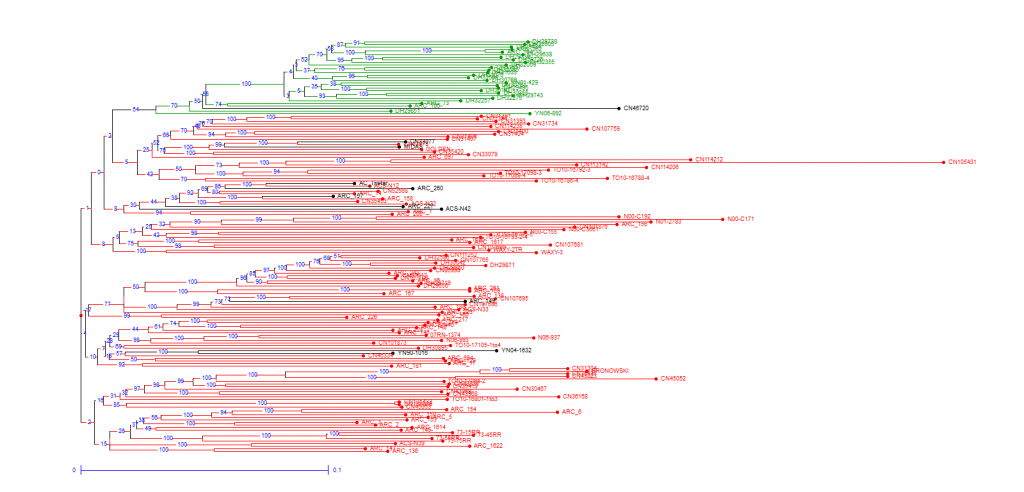Key Result
This project generated information and tools that will be useful in breeding for low temperature tolerance in canola, including successfully ranking Brassica napus, Brassica rapa, Brassica oleracea, and Brassica juncea lines for seed germination and emergence at low temperature using seed produced under field conditions.
Project Summary
Introduction
Seedling establishment of Brassica species is often hindered by unfavorable environments such as relatively low soil temperatures. In the Canadian Prairies, low temperature early in the season is a limiting factor for a rapid and uniform establishment of spring canola and may cause significant productivity losses.
Objectives
The overall objective was to determine the effects of cold on the performance of spring canola. More specifically to :
- Determine the effects of low temperature on seed germination of Brassica napus, Brassica rapa, Brassica oleracea genotypes.
- Determine the effects of frost on seedling performances in Brassica napus, B. rapa, B. oleracea genotypes.
- Evaluate whether germination and emergence varied between seed size.
- Perform association mapping to identify markers linked to alleles for improved cold tolerance.
- Validate new techniques to screen large canola populations for cold tolerance.
Results
It was hypothesized that seed germination and emergence is predicted to be shaped by temperature, and may differ for small and large seeds. Germination and emergence were tested at temperatures that varied from 5°C to 15°C, with 5°C increments.
As expected, time required for onset of germination and emergence, 50 per cent, and maximum is correlated with the temperature. The progressive increase in time of germination and emergence as a results of lowering the temperature, varied with the species and genotypes. At 15°C, the time required to the onset of germination and emergence ranged from two to four days for all genotypes. In most cases, the maximum emergence rate exceeded 99%. At 5°C, there was significant variability in seed germination and emergence rates among the tested genotypes, ranging from 10 to 20 days after seeding.
Time required for 50 per cent and maximum germination and emergence is much longer compared to that recorded at higher temperatures, suggesting that 5°C may be considered as an optimum temperature for selecting spring canola to low temperature tolerance. In addition, some genotypes did not achieve 50% seeds germination, thus revealing a greater sensitivity to low temperature during germination and emergence. On the other hand, the researchers observed several genotypes that exhibited adequate performance at the lowest temperatures.
Seed size had no significant effects on germination and emergence rates of spring canola genotypes. However, as temperature decreased, smaller-seeded genotypes germinated and emerged slightly faster than larger-seeded genotypes. The higher germination and emergence in the smaller- than the larger-seeded genotypes may imply that temperature requirements is an imposing standard of performance of germination signal in the larger-seeded genotypes. Interspecific variation in the germination and emergence responses to temperatures suggested that Brassica juncea exhibited low temperature tolerance than Brassica napus, Brassica rapa, and Brassica oleracea.
Conclusion
Breeding for low temperature tolerance can be very challenging. While some progress has been made in spring seeded canola, the gain was masked by location variation in cold spring soil from year to year. To improve efficiency and increase the tolerance of low temperature, canola breeder must exploit new screen techniques to complete previously used methods. This project has generated a huge amount of information and tools that will be useful in breeding programs and other projects aimed at understanding the physiology and genomics of low temperature tolerance in spring canola. The study demonstrated that chlorophyll fluorescence parameters can be used in combination with molecular markers to achieve efficient gain.
Future research
To build on the current research, these studies are recommended:
- Genomics and proteomics studies needed to identify candidate genes that can be used for potential genetic engineering of new high productive varieties.
- An introgression of cold hardiness from genotypes expressing high tolerance to low temperature into high yield commercial genotypes must be made. We have already identified these genotypes with high and low tolerance.






